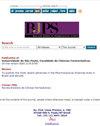Health education can save the environment from medicine residues
IF 0.9
4区 医学
Q4 PHARMACOLOGY & PHARMACY
引用次数: 0
Abstract
The incorrect disposal of medicines and their environmental impact has been related to the health medicalization and the improper use of medication by society. In this sense, it is very important to know the profile of drug disposal for foster health policies. The aim was to identify the profile of disposal of medicines by the population, including the cost perspective. This is an inquiry descriptive study that began in September 2019. Medicine disposal health education program was carried out over six months in two University pharmacies. A questionnaire for sociodemographic and discarded medicines data collection was applied. Logistic regression analysis for variables association of correct disposal and the chi-square and t-student analysis for comparison between disposal programs were performed for a level of 5% and test power of 80%. Medicines weighed 23.3 kg and 28.5 kg, with the cost variation from US$ 13.5 to US$ 16.1 until the final treatment. The correct disposal was strongly associated with the disposal reason (p=0.013), source of information (p=0.006), prescription (p=0.03), form of use (p=0.01), acquisition source (p=0.001), cost with medication (p=0.0001), education (p=0.028) and age (p=0.05). The correct medicine disposal was associated with important features of the community related to education health.健康教育可以从药物残留中拯救环境
本文章由计算机程序翻译,如有差异,请以英文原文为准。
求助全文
约1分钟内获得全文
求助全文
来源期刊

Brazilian Journal of Pharmaceutical Sciences
PHARMACOLOGY & PHARMACY-
CiteScore
1.40
自引率
0.00%
发文量
165
审稿时长
7.5 months
期刊介绍:
The Brazilian Journal of Pharmaceutical Sciences accepts for publication Original Papers applicable to the fields of Pharmaceutical Sciences; Reviews and Current Comment Articles, which are published under the Scientific Editor and Associate Editors invitation to recognized experts or when they are spontaneously submitted by the authors in the form of abstracts to have their importance evaluated. A critical view of the subject with insertions of results of previous works in the field in relation to the state of art must be included; Short Communications reporting new methods and previews of works on researches of outstanding importance in which originality justify a quick publication. A maximum of 2000 words excluding tables, figures and references is an acceptable limit. One table, one figure and ten references may be added, and Book Reviews of the latest editions of books, prepared by specialists invited by the Scientific Editor and Associate Editors. Thematic Supplements as well as those related to scientific meetings can be published under the Scientific Editor and/or Associate Editors agreement.
 求助内容:
求助内容: 应助结果提醒方式:
应助结果提醒方式:


